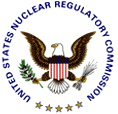NRC Proposes $17,600 Fine for International Radiography and Inspection Services, Inc.
 | NRC NEWS U. S. NUCLEAR REGULATORY COMMISSION OFFICE OF PUBLIC AFFAIRS, REGION IV 611 Ryan Plaza Drive, Suite 400, Arlington TX 76011 | |
RIV: 99-21
May 6, 1999
| CONTACT: | Breck Henderson (817) 860-8128/e-mail: bwh@nrc.gov |
NRC PROPOSES $17,600 FINE FOR
INTERNATIONAL RADIOGRAPHY AND INSPECTION SERVICES, INC.
Radiographers disciplined for violating safety rules
The U.S. Nuclear Regulatory Commission staff has proposed a $17,600 civil penalty against International Radiography and Inspection Services, Inc. (IRIS), of Tulsa, for numerous violations of basic radiation safety requirements which resulted in a radiation overexposure to one worker. Based on its review the NRC determined that some of the violations were committed deliberately by IRIS employees.
The worker received a dose of about 10.8 rem to the whole body and about 164 rem to one hand. The federal limits are 5 rem per year whole body dose and 50 rem per year to the extremities (including the hands). During the NRC's investigation an NRC medical consultant reviewed the results of several medical examinations performed for the exposed worker. The medical consultant concluded that the radiation dose received by the worker did not result in any immediate symptoms.
A "rem" is a unit of radiation dose that relates to the amount of energy deposited in a human being as a result of exposure to penetrating radiation. On average, a person would likely receive a radiation dose of about 0.3 rem each year from exposure to environmental background radiation from naturally occurring radioactive elements, cosmic radiation and medical X-rays. A dose of 500 rem to the whole body would be fatal for 50 percent of people receiving such a dose.
In the incident resulting in the overexposure, two IRIS employees were using high-energy radiation to check for flaws in welds in a pipe in much the same way X-rays are used in medical applications. They failed to follow basic safety procedures including surveying the area around their equipment to be certain the highly radioactive source was properly shielded when they completed their work. In addition, they failed to wear personal radiation monitoring devices when they approached the equipment. As a result of these failures, they were not aware that the source was not shielded and one of the workers entered a high radiation field. The employees then attempted to cover up their actions from company officials.
The numerous violations were grouped into two Severity Level II violations, which are each subject to an $8,800 base civil penalty. The NRC uses a four-level scale to rate the severity of violations, with Level I being the most serious. In addition to fining the company, the NRC has issued orders to the IRIS employees involved in the incident. James S. Dawson, a radiographer, has been banned from participating in NRC licensed activities, which includes working as a radiographer, for five years. Ms. Shelia N. Burns, an assistant radiographer, has been banned from NRC licensed activities for three years.
At a predecisional enforcement conference held on March 18 company officials admitted to the violations and made it clear that the actions of the workers were contrary to their training and company expectations.
Nevertheless, NRC Deputy Executive Director for Regulatory Effectiveness Malcolm R. Knapp, said in a letter to IRIS Vice President Kevin Wieland, "In considering the enforcement action in this case, the NRC recognized IRIS's efforts in investigating this incident and identifying the violations, including the identification of the attempt by the involved employees to cover up the true nature of the incident. Further, the NRC recognizes IRIS's prompt and aggressive corrective actions following the incident. . . However, given the egregiousness and deliberate nature of the violations in this case, I am issuing the enclosed Notice of Violation and Proposed Imposition of Civil Penalties in the amount of $17,600."
The civil penalties could have been higher had IRIS not cooperated effectively in identifying and correcting the violations, Mr. Knapp also said. The company has 30 days to pay the penalty or file a protest. If the protest is denied the company may request a hearing by the Commission.
Page Last Reviewed/Updated Thursday, March 25, 2021